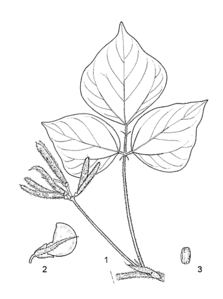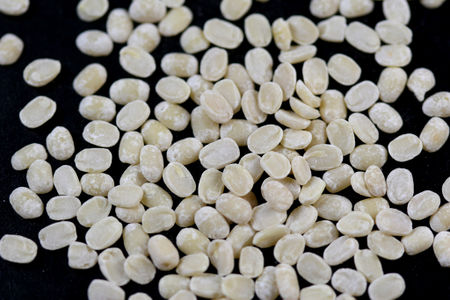Vigna mungo : Différence entre versions
De PlantUse Français
(Mise à jour le Fri222014) |
(→Classification) |
||
| (17 révisions intermédiaires par 2 utilisateurs non affichées) | |||
| Ligne 1 : | Ligne 1 : | ||
{{Page espèce (plante à graines) | {{Page espèce (plante à graines) | ||
| − | |image = | + | |image = Black gram.jpg |
| − | |légende = | + | |légende = urd noir |
| − | |auteur = | + | |auteur = (L.) Hepper |
| − | |ordre = | + | |ordre = Fabales |
| − | |famille = | + | |famille = Fabaceae |
| − | |genre = | + | |genre = Vigna |
| − | |nb chromosomes = 2n = | + | |nb chromosomes = 2n = 22, 24 |
|origine = aire d'origine | |origine = aire d'origine | ||
|statut = sauvage ou cultivé | |statut = sauvage ou cultivé | ||
| + | |français = '''haricot urd''' | ||
| + | |anglais = '''urd bean''' | ||
| + | }}{{Encadré | ||
| + | |color=lightgreen | ||
| + | |titre=Résumé des usages | ||
| + | |texte=*légume sec | ||
}} | }} | ||
| − | * | + | == Description == |
| − | * | + | *plante herbacée annuelle érigée, poilue, atteignant 1 m de haut, parfois volubile |
| − | + | *tige abondamment ramifiée dès la base, cannelée | |
| − | + | *feuilles alternes, 3-foliolées ; stipules peltées, ovales ; pétiole de 6–20 cm de long | |
| − | + | *folioles ovales ou rhombiques-ovales, de 4–10 cm × 2–7 cm, entières, acuminées | |
| + | *inflorescence : fausse grappe axillaire ; pédoncule jusqu’à 18 cm de long | ||
| + | *fleurs jaunes, à étendard de 12–16 mm de large et carène enroulée en spirale avec un appendice terminal en forme de corne | ||
| + | *gousse cylindrique de 4–7 cm × 0,5 cm, érigée ou presque, avec de longs poils et un bec crochu et court, contenant 4–10 graines | ||
| + | *graines ellipsoïdes, jusqu’à 5 mm de long, à bouts carrés et à hile en relief et concave, généralement noires ou tachetées, parfois vertes | ||
| + | *plantule à germination épigée | ||
| + | <gallery mode="packed"> | ||
| + | File:Linedrawing Vigna mungo.gif|1, partie de rameau en fruits ; 2, fleur ; 3, graine. Source: PROSEA | ||
| + | File:White lentil.jpg|urd décortiqué | ||
| + | </gallery> | ||
== Noms populaires == | == Noms populaires == | ||
| + | {| class="wikitable" style="width:100%;" | ||
| + | | français | ||
| + | | haricot urd, urd | ||
| + | |- | ||
| + | | anglais | ||
| + | | black gram, urd bean, urad bean | ||
| + | |- | ||
| + | | allemand | ||
| + | | Urd-Bohne | ||
| + | |- | ||
| + | | italien | ||
| + | | fagiolo urd | ||
| + | |- | ||
| + | | espagnol | ||
| + | | judía urd | ||
| + | |- | ||
| + | | portugais | ||
| + | | feijão urida, feijão da China | ||
| + | |- | ||
| + | | swahili | ||
| + | | mchooko mweusi | ||
| + | |- | ||
| + | | hindi | ||
| + | | uṛad, uṛd, uṛid | ||
| + | |- | ||
| + | | vietnamien | ||
| + | | đậu đen | ||
| + | |} | ||
| − | |||
== Classification == | == Classification == | ||
| + | ''Vigna mungo'' (L.) Hepper (1956) | ||
| + | |||
| + | basionyme : | ||
| + | *''Phaseolus mungo'' L. (1767), non Roxb. (1832) et auct. | ||
| + | |||
| + | synonyme : | ||
| + | *''Phaseolus radiatus'' Roxb. (1832) non L. (1753) | ||
| + | |||
| + | Linné s'est trompé en appelant le mungo ''Phaseolus radiatus'' et l'urd ''Phaseolus mungo''. Cette erreur a été remarquée par Roxburgh qui a corrigé en inversant l'usage de ces noms. Sa décision a entrainé une longue période de confusion, encore augmentée par le transfert de ces espèces au genre ''Vigna''. Malheureusement, les règles de nomenclature ([Shenzhen Code) art. 11.3 du Code de Shenzhen]) nous obligent à suivre le choix originel de Linné pour l'épithète. Ce n'est donc pas le mungo qui s'appelle ''Vigna mungo'', mais l'urd. Le mungo est ''[[Vigna radiata]]''. | ||
== Cultivars == | == Cultivars == | ||
| Ligne 29 : | Ligne 80 : | ||
== Références == | == Références == | ||
| + | *Castillo, Cristina & Fuller, Dorian Q., 2010. Still too fragmentary and dependent upon chance? Advances in the study of early Southeast Asian archaeobotany. pp. 91-111. In: ''50 Years of Archaeology in Southeast Asia'', ed. by Bellina, Bacus, Pryce, Weissman Christie. London, River Books. | ||
| + | *Chauvet, Michel, 2018. ''[[Encyclopédie des plantes alimentaires]]''. Paris, Belin. 880 p. (p. 417) | ||
| + | *Fuller, Dorian Q., 2007. Contrasting Patterns in Crop Domestication and Domestication Rates: Recent Archaeobotanical Insights from the Old World. ''Annals of Botany'', '''100''': 903–924. [http://dx.doi.org/doi:10.1093/aob/mcm048 doi:10.1093/aob/mcm048] | ||
== Liens == | == Liens == | ||
| − | |||
| − | |||
*[http://www.biodiversitylibrary.org/search.aspx?SearchTerm=Vigna%20mungo&SearchCat= BHL] | *[http://www.biodiversitylibrary.org/search.aspx?SearchTerm=Vigna%20mungo&SearchCat= BHL] | ||
| − | *[http://ecocrop.fao.org/ecocrop/srv/en/ | + | *[http://ecocrop.fao.org/ecocrop/srv/en/cropView?id=2149 FAO Ecocrop] |
| − | *[http://www.feedipedia.org/ Feedipedia] | + | *[http://www.feedipedia.org/content/feeds?species=13543 Feedipedia] |
| − | *[ | + | *[https://npgsweb.ars-grin.gov/gringlobal/taxonomydetail.aspx?id=444359 GRIN] |
| − | + | ||
*[http://www.ipni.org/ipni/simplePlantNameSearch.do?find_wholeName=Vigna%20mungo&output_format=normal&query_type=by_query&back_page=query_ipni.html IPNI] | *[http://www.ipni.org/ipni/simplePlantNameSearch.do?find_wholeName=Vigna%20mungo&output_format=normal&query_type=by_query&back_page=query_ipni.html IPNI] | ||
*[http://mansfeld.ipk-gatersleben.de/pls/htmldb_pgrc/f?p=185:45:1329164412874601::NO::P7_BOTNAME,P7_DB_CHECKBOX1,P7_DB_CHECKBOX2,P7_DB_CHECKBOX4:Vigna%20mungo,,, Mansfeld] | *[http://mansfeld.ipk-gatersleben.de/pls/htmldb_pgrc/f?p=185:45:1329164412874601::NO::P7_BOTNAME,P7_DB_CHECKBOX1,P7_DB_CHECKBOX2,P7_DB_CHECKBOX4:Vigna%20mungo,,, Mansfeld] | ||
| Ligne 43 : | Ligne 94 : | ||
*[http://www.plantnames.unimelb.edu.au/Sorting/Vigna.html Multilingual Plant Name Database] | *[http://www.plantnames.unimelb.edu.au/Sorting/Vigna.html Multilingual Plant Name Database] | ||
*[http://www.hort.purdue.edu/newcrop/nexus/Vigna_mungo_nex.html NewCrop Purdue] | *[http://www.hort.purdue.edu/newcrop/nexus/Vigna_mungo_nex.html NewCrop Purdue] | ||
| + | *NIAS Genebank (Japon) : [http://www.gene.affrc.go.jp/databases-plant_images_detail_en.php?plno=5420610009 var. ''mungo''] et [http://www.gene.affrc.go.jp/databases-plant_images_detail_en.php?plno=5420610035 var. ''silvestris''] | ||
*[http://www.theplantlist.org/tpl1.1/search?q=Vigna+mungo Plant List] | *[http://www.theplantlist.org/tpl1.1/search?q=Vigna+mungo Plant List] | ||
*[http://pfaf.org/user/Plant.aspx?LatinName=Vigna%20mungo Plants for a future] | *[http://pfaf.org/user/Plant.aspx?LatinName=Vigna%20mungo Plants for a future] | ||
| − | *[ | + | *[[:en:Vigna mungo (PROSEA)|PROSEA sur Pl@ntUse]] |
*[[Vigna mungo (PROTA)|PROTA sur Pl@ntUse]] | *[[Vigna mungo (PROTA)|PROTA sur Pl@ntUse]] | ||
| − | |||
*[http://www.tela-botanica.org/page:eflore_bdtfx?referentiel=bdtfx&niveau=2&module=fiche&action=fiche&type_nom=nom_scientifique&nom=Vigna%20mungo Tela Botanica] | *[http://www.tela-botanica.org/page:eflore_bdtfx?referentiel=bdtfx&niveau=2&module=fiche&action=fiche&type_nom=nom_scientifique&nom=Vigna%20mungo Tela Botanica] | ||
*[http://tropical.theferns.info/viewtropical.php?id=Vigna%20mungo Useful Tropical Plants Database] | *[http://tropical.theferns.info/viewtropical.php?id=Vigna%20mungo Useful Tropical Plants Database] | ||
*[https://fr.wikipedia.org/wiki/Vigna%20mungo Wikipédia] | *[https://fr.wikipedia.org/wiki/Vigna%20mungo Wikipédia] | ||
*[http://www.wikiphyto.org/wiki/Vigna%20mungo Wikiphyto] | *[http://www.wikiphyto.org/wiki/Vigna%20mungo Wikiphyto] | ||
| + | |||
| + | [[Category:Vigna]] | ||
| + | [[Catégorie:Légume sec, important]] | ||
Version actuelle en date du 24 avril 2020 à 18:41
Vigna mungo (L.) Hepper
| Ordre | Fabales |
|---|---|
| Famille | Fabaceae |
| Genre | Vigna |
2n = 22, 24
Origine : aire d'origine
sauvage ou cultivé
| Français | haricot urd |
|---|---|
| Anglais | urd bean |
Résumé des usages
- légume sec
Sommaire
Description
- plante herbacée annuelle érigée, poilue, atteignant 1 m de haut, parfois volubile
- tige abondamment ramifiée dès la base, cannelée
- feuilles alternes, 3-foliolées ; stipules peltées, ovales ; pétiole de 6–20 cm de long
- folioles ovales ou rhombiques-ovales, de 4–10 cm × 2–7 cm, entières, acuminées
- inflorescence : fausse grappe axillaire ; pédoncule jusqu’à 18 cm de long
- fleurs jaunes, à étendard de 12–16 mm de large et carène enroulée en spirale avec un appendice terminal en forme de corne
- gousse cylindrique de 4–7 cm × 0,5 cm, érigée ou presque, avec de longs poils et un bec crochu et court, contenant 4–10 graines
- graines ellipsoïdes, jusqu’à 5 mm de long, à bouts carrés et à hile en relief et concave, généralement noires ou tachetées, parfois vertes
- plantule à germination épigée
Noms populaires
| français | haricot urd, urd |
| anglais | black gram, urd bean, urad bean |
| allemand | Urd-Bohne |
| italien | fagiolo urd |
| espagnol | judía urd |
| portugais | feijão urida, feijão da China |
| swahili | mchooko mweusi |
| hindi | uṛad, uṛd, uṛid |
| vietnamien | đậu đen |
Classification
Vigna mungo (L.) Hepper (1956)
basionyme :
- Phaseolus mungo L. (1767), non Roxb. (1832) et auct.
synonyme :
- Phaseolus radiatus Roxb. (1832) non L. (1753)
Linné s'est trompé en appelant le mungo Phaseolus radiatus et l'urd Phaseolus mungo. Cette erreur a été remarquée par Roxburgh qui a corrigé en inversant l'usage de ces noms. Sa décision a entrainé une longue période de confusion, encore augmentée par le transfert de ces espèces au genre Vigna. Malheureusement, les règles de nomenclature ([Shenzhen Code) art. 11.3 du Code de Shenzhen]) nous obligent à suivre le choix originel de Linné pour l'épithète. Ce n'est donc pas le mungo qui s'appelle Vigna mungo, mais l'urd. Le mungo est Vigna radiata.
Cultivars
Histoire
Usages
Références
- Castillo, Cristina & Fuller, Dorian Q., 2010. Still too fragmentary and dependent upon chance? Advances in the study of early Southeast Asian archaeobotany. pp. 91-111. In: 50 Years of Archaeology in Southeast Asia, ed. by Bellina, Bacus, Pryce, Weissman Christie. London, River Books.
- Chauvet, Michel, 2018. Encyclopédie des plantes alimentaires. Paris, Belin. 880 p. (p. 417)
- Fuller, Dorian Q., 2007. Contrasting Patterns in Crop Domestication and Domestication Rates: Recent Archaeobotanical Insights from the Old World. Annals of Botany, 100: 903–924. doi:10.1093/aob/mcm048
Liens
- BHL
- FAO Ecocrop
- Feedipedia
- GRIN
- IPNI
- Mansfeld
- Moerman, Native American Ethnobotany
- Multilingual Plant Name Database
- NewCrop Purdue
- NIAS Genebank (Japon) : var. mungo et var. silvestris
- Plant List
- Plants for a future
- PROSEA sur Pl@ntUse
- PROTA sur Pl@ntUse
- Tela Botanica
- Useful Tropical Plants Database
- Wikipédia
- Wikiphyto


